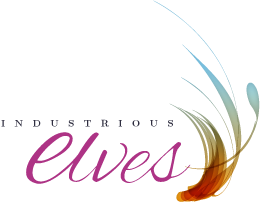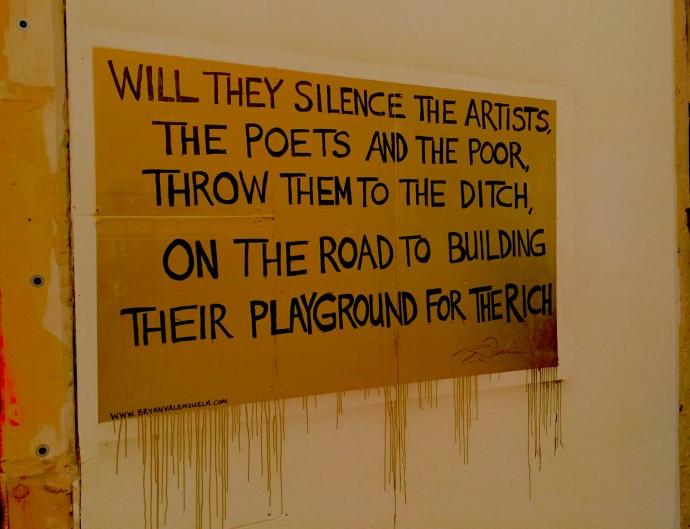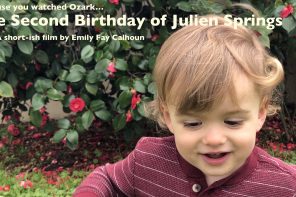We need a new religion. I pointed my finger at a friend during the third glass of wine. We may think as progressives that we don’t need one. We may win a few battles in the Culture War. But memes and slogans and dramatic stands at photo-op moments are insufficient. We need our own moral code! I shouted.
“Emily, calm down,” he said. “It’s Valentine’s Day, for chrissakes. People are pretending to enjoy themselves.”
What would a new religion look like? Many people seem to be into the idea of re-purposing Christianity. I think it comes with too much baggage. I’m no religious scholar, but show me an existing religion that makes sense in a post-gender world, for example. I think a new religion must be one that inspires moral behavior for the sake of today, not the carrots and sticks of the hereafter. A belief that beauty exists now, here, and is worth protecting, celebrating, honoring and defending.
I gaze through the blinds of my windows as I ponder this. The muted tones of a winter’s midday. A stately redwood, barren sycamores, fanning palm trees towering over a mossy gravel alleyway between my neighbor’s house and mine. The horizon is a patchwork of sheds and shrubs and fences of fern and wood and chain link. A few cars clustered in the parking lot of a theater (for plays). The bright green corner of a park where my friends bring their toddlers to play.
But I’m also conscious of what I don’t want to see. There are drug-addled transients on stolen bikes that ride through this alleyway looking for opportunities. There are homeless encampments under the freeway that hums beyond. There are lonely and sick people inside the houses. They are all my neighbors, and I am theirs. I don’t need to look much beyond my neighborhood to find reasons for grace and charity and service. Not for the sake of acquiring one day my own heavenly cloud with maidens and milk and honey. Not for the sake of one day being with Jesus. But for the sake of those toddlers in the park, that theater where actors play, that ancestral redwood, those hungry transients. For the sake of the beauty in all of it.
I don’t have much of that in mind, however, as I walk up the steep steps of Nob Hill, towards Grace Cathedral, where an elegy for the Ghost Ship victims is about to begin. I tell myself that I’m sure there is nothing about the tragedy that is new. I’m sure there have always been poor people living in dangerous conditions. I’m sure there have always been marginalized people taking risks to make space to feel less marginal. And yet I can’t seem to detach this horrific event from its contemporary context – it’s Here-and-Now-ness. This happened on the outskirts of a bastion of incredible and increasing wealth and prosperity. Wedged between the all-consuming suburban monoculture and the Silicon Monarchy are the forgotten people who made the culture that is now the fully commodified currency of real estate developers and tourism. Wealth has migrated back to the urban core because the wealthy want to be enriched by art, by culture, by the life of a city. For a period of time, in the right circumstances, both might be able to co-exist, perhaps in NYC for the past 100 years. But a tipping point seems to have occurred here in San Francisco.
I trudge up the steep hill at happy hour on a chilly Thursday. The bars are full of bros in white collars watching basketball. A sign on a door says “Studios starting at $2300.” That’s two thousand, three hundred dollars per month. The restaurants look warm and glow with candles on white table cloths and delicate dishes and fine wines. The people that died in that Oakland warehouse don’t hang out here. They don’t have anything to do with this world. Why drag us to the top of this hill of rich people to pay tribute to them? I wonder.
“Where do I sit?” I asked the Episcopal clergyman that greeted me at the entrance. I saw no pews.
“We are only the hosts of this event,” he smiled. “The organizers want you to feel free to roam around the space and participate. Sit wherever you feel comfortable.”
I’ve been to many, MANY, church services. Funerals, weddings, Sunday mornings with shrieking evangelicals, Saturday evening masses with dutiful Catholics, hours of standing with the chanting Orthodox, standing up, kneeling down, holding hands, eating wafers and sips of wine and being blessed, singing and crying and testifying. I’ve spoken in tongues (whatever that means) and played guitar and raised my hands. I’ve even washed people’s feet and watched people get dunked free of guilt in a jacuzzi. But I had never seen a church service like this.
A neon banner of lavender and blue lights hung down from one side of the vaulted nave, its asymmetrical, random-like placement in a Gothic-style cathedral startling and new. A priest with a glow stick hanging like a cross over his vestments. A person on stilts in white robes and a feather crown. As the service began, people clustered around the center of the main hall to watch and hear a throat singer – shells clinking from his native garb – project his long, mournful droning song as he paced across the labyrinth pattern of the marble floor. Circling him, haunting him, was what looked like his spirit animal, a lean young man in a black gauze toga, crouching and bending and hopping noiselessly around him, like a strange dance of Adho Mukha Svanasana (downward dog) and Bakasana (crow).
Then an opera singer in the rafters above. Then a cellist and violinist played Halvorsen. Then a poet named Tom Emanuel read from the lectern, while photos of the victims were projected eerily large across the raised altar behind him.
Spirit seeks Body
Word seeks Flesh
Art seeks Home
Not old folks home
(geriatric, gentrifying,
dead stone housing dying breath)
but Sanctuary and streams
of Living Water
I was reminded of the Temple at Burning Man, which had struck me when I visited it as the Goddess standing opposite the Man, a kind of yin-yang juxtaposition, a place where prayers and condolences are received, a safe and sacred place for sorrow and loss. I remember meeting a young person, barely 20, who told me that he was alive only because of this temple. The losses he had felt in his short life, the pain he had numbed with heroin, he was overcoming only because of what had occurred for him in this temple, constructed as a temporary installation at a pagan-like art festival, and the people who brought him to it.
Then I understood. An elegy in a grand cathedral at the top of this hill of ridiculous wealth and privilege is an act of rebellion, an act of occupation. We are still here. We belong here.
Everyone needs art. The entrepreneurs and barons keep part-time residences in cities to be near Culture. The tourists spend their hard-earned savings to travel to cities to feel Cultured. But a diversity of people of mixed incomes and flavors are what built the experience, and chief among them are the artists. The artists who make this experience possible make meaning of their lives and our lives and the world around us by making art. The making itself is a ritual of faith. Faith that meaning and beauty can be found in a world of pain and loss and injustice. A person entranced by creative energy is in a prayerful state. The practice of art-making cannot be commodified no more than a prayer can be.
Imagine a monk only being able to live as a monk if he sells his prayers. The church provides the monk with monastery and the nun with convent because what they do in those safe and contemplative spaces enriches the world around them. We don’t let them turn to ash in unsafe, unsanctioned dwellings because they spend their time praying instead of making money. We don’t shake our heads at them and tell them it was their own damn fault for choosing to live that way.
If our cities don’t provide safe and sanctioned spaces for artists, they will become soul-less, god-less places, no better than the suburbs. Artists that once fled the suburbs for cities will be pushed from cities to… where? Where will they go? This is the premise of my new documentary project. I don’t know where it will lead and what the answers are, but I look forward to speaking with many artists and arts enthusiasts around the country to find out.





